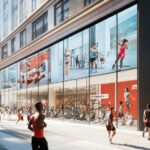Foot traffic insights are revolutionizing the way restaurants approach their marketing and operations. By analyzing how many customers visit their establishment and when, restaurants can refine their advertising strategies, optimize staffing, and enhance the overall customer experience. This article delves into the importance of foot traffic data, its significance for restaurant owners, and practical ways to take advantage of these findings for maximum success. Whether you aim to identify peak hours, create targeted promotions, improve customer loyalty, or enhance your restaurant advertising, valuable information is available to help you achieve your goals.
Understanding Foot Traffic Insights and Consumer Behavior

Foot traffic insights are invaluable for restaurants seeking to enhance their marketing and operational efficiency. This data reflects the patterns and frequency of visits by potential customers to a restaurant or any other location. Understanding these insights helps in creating effective marketing strategies based on customer behavior and visit frequency.
By leveraging foot traffic data, businesses can create targeted advertisements and enhance customer experiences. Analyzing location data and customer behavior provides restaurants with consumer insights that help them understand the elements influencing their promotional strategies, seasonal trends, and advertising effectiveness.
Additionally, demographic insights give the power to restaurants to make informed decisions by offering a clearer understanding of what potential customers desire, thereby fostering brand loyalty and increasing foot traffic. Demographic profiling and competition analysis are crucial for understanding the target audience and enhancing customer retention.
What is Foot Traffic Data and How is it Collected?
Foot traffic data refers to measurable information that indicates the number of people visiting a location at a specific time. This data is typically collected through mobile analytics, heat maps, and sensor technology, providing real-time information on visitor counts and traffic patterns.
For businesses, foot traffic data is crucial for optimizing marketing channels and enhancing customer acquisition strategies. Utilizing technologies such as Wi-Fi tracking, mobile tracking, and Bluetooth beacons allows brands to gain insights into the sources of traffic and understand audience behavior more effectively.
For instance, by tracking foot traffic data alongside external variables like weather conditions or nearby sporting events, businesses can make informed decisions regarding advertising and staffing. The integration of these measurement techniques provides valuable visibility into visitor patterns, enabling businesses to adapt their advertising strategies to evolving customer preferences.
The Importance of Foot Traffic Insights for Restaurants

Foot traffic insights are essential for restaurants as they provide valuable information about the customer journey and enable businesses to enhance their marketing strategies, local SEO, and advertising channels to better align with local demand.
Understanding when consumers visit allows restaurants to identify optimal times for reaching out with promotions or community engagement activities, ultimately boosting brand loyalty and visibility enhancement when offerings align with consumer preferences.
These insights can also enhance marketing promotions by ensuring they are tailored to peak visitation hours.
Furthermore, utilizing foot traffic data can improve local SEO efforts, helping restaurants achieve higher rankings in search results and attracting foot traffic from nearby customers.
By having a clearer understanding of when and where customers gather, restaurants can develop and implement strategies that significantly enhance customer retention, customer satisfaction, and competitive positioning.
Personalized experiences and timely promotions based on foot traffic insights will lead to increased repeat visits and foster a sense of community around the brand.
Utilizing Foot Traffic Insights for Advertising
Leveraging foot traffic insights for advertising enables restaurants to develop targeted and tailored marketing strategies that resonate more effectively with their unique audiences.
By analyzing customer behavior and identifying key traffic patterns, restaurants can employ geo-targeting techniques to reach potential customers at optimal times and locations. This not only enhances the effectiveness of their advertising but also allows restaurants to plan seasonal promotions and events based on anticipated changes in foot traffic and dining trends.
Identifying Peak Hours and Targeting Customers

Restaurants leverage foot traffic metrics, including traffic patterns and mobile foot traffic data, to identify their peak business hours. This information enables them to engage with consumers at optimal times and improve their advertising ROI.
By understanding when peak traffic occurs, restaurants can tailor their advertising strategies to maximize engagement and ensure that promotional deals coincide with times when customers are most likely to dine out. This approach can significantly improve advertising effectiveness and visibility.
For instance, restaurants can enhance the customer experience by implementing loyalty rewards programs that encourage visits during off-peak hours. They can achieve this by incentivizing customers to return during these quieter times, such as offering double loyalty points for visits made during off-peak hours.
Real-time data also allows restaurants to adjust staffing levels accordingly, ensuring they can meet customer demand without overstaffing, which could cut into profits. Furthermore, foot traffic data can inform targeted marketing strategies by providing insights into customer behavior.
By analyzing which days of the week and times of day customers frequent the restaurant, they can run promotions that cater to customer needs, thereby improving customer loyalty and increasing business revenue.
Creating Location-Based Ads and Promotional Campaigns
Creating location-based ads and promotions is a powerful strategy for restaurants to enhance visibility and attract customers. By utilizing location data and geolocation data, restaurants can develop targeted and relevant promotional offers for local patrons, which fosters a sense of community.
This approach increases the effectiveness of digital advertisements by ensuring they reach the intended audience and align with customers’ needs and neighborhood trends. Effective use of online presence and social media marketing can further boost advertisement targeting.
Successful marketing campaigns often involve partnerships with local businesses. By collaborating with nearby establishments, restaurants can expand their reach and create more effective marketing initiatives. These partnerships allow for bundled promotions that benefit both brands by increasing local brand awareness and cross-promotion opportunities.
Incorporating community outreach programs is also vital for customer acquisition. By hosting events or sponsoring local activities, restaurants can establish themselves as integral parts of the community. This not only raises awareness of the restaurant but also instills a sense of ownership among customers, encouraging repeat visits and fostering loyalty. Event marketing is a key aspect of building strong community engagement.
Measuring the Effectiveness of Advertising Strategies

Measuring the effectiveness of advertising strategies for restaurants is essential for optimizing their return on investment (ROI) and refining their marketing efforts. Using proper engagement metrics, restaurants can better understand the impact of their campaigns.
By evaluating campaign performance through metrics such as sales data, customer feedback, and online engagement rates, restaurants can identify which advertising strategies yield the best results and make necessary adjustments. Analyzing ad performance metrics is crucial for continuous improvement.
Loyalty metrics can reveal how effectively campaigns resonate with returning customers, which is crucial for fostering long-term relationships and encouraging repeat business. Loyalty programs play a significant role in enhancing customer retention and satisfaction.
Additionally, conversion rates are important as they indicate how successful specific promotions are in transforming prospects into actual diners. Monitoring conversion rates helps in determining the effectiveness of targeted messaging and call-to-action strategies.
Marketing analytics tools enable restaurants to assess not only the overall performance of their advertising strategies but also to segment results by time, location, and demographic factors. This segmentation allows for a more targeted approach to advertising that aligns closely with their audience. Geographic segmentation and demographics analysis are key components of effective data-driven marketing.
Data-driven marketing provides restaurants with the insights needed to make informed decisions, ensuring that every advertising dollar is wisely spent to reach potential customers.
Other Uses of Foot Traffic Insights for Restaurants
Foot traffic insights serve purposes beyond advertising; they can assist businesses in optimizing staff allocation and managing inventory more effectively, ultimately enhancing the customer experience. Effective use of business intelligence and analytics tools can significantly improve operational efficiency.
By analyzing foot traffic data, restaurants can better align their staffing needs with expected peak traffic times and manage their inventory to ensure that the right products are available for consumers.
Optimizing Staffing and Inventory Management
Optimizing staffing and inventory management is essential for restaurants to adapt to changing visitor frequency and demand.
By utilizing foot traffic data, restaurants can more accurately predict demand, enabling them to determine the appropriate staffing and inventory levels necessary to enhance operational efficiency and service quality. This approach helps in improving user experience and ensuring customer satisfaction.
Foot traffic insights allow restaurant managers to identify when and how much to adjust staffing schedules by analyzing which customer touchpoints within their establishment are the most popular and when they experience peak activity. Visual advertising and data visualization can provide clear insights into these patterns.
Incorporating heat maps that visually represent traffic flow helps managers better understand busy areas and peak times, allowing them to engage customers more effectively and reduce wait times. This can also enhance in-store visits and overall dining experience.
Additionally, useful metrics such as sales per labor hour and inventory turnover ratios provide a comprehensive view of operational effectiveness. These metrics are key for marketing budget optimization and long-term revenue growth.
Leveraging these insights for sales optimization not only streamlines operations but also fosters a seamless customer experience that enhances loyalty and increases revenue. Effective use of marketing analytics ensures that strategic decisions are data-driven and focused on revenue growth.
Improving Customer Experience and Loyalty
Improving customer experience is one of the key objectives that restaurants aim to achieve by utilizing foot traffic insights and location analytics. This focus stems from the understanding that developing strong brand loyalty among customers can significantly enhance customer retention and engagement metrics. Much of the data collected and analyzed, including consumer insights and demographic profiling, can be leveraged to support this goal.
As restaurants gather foot traffic insights, including visit frequency and traffic patterns, they can implement targeted loyalty programs and community outreach efforts to enhance the overall customer experience and customer satisfaction.
By using foot traffic insights, including geographic segmentation and consumer behavior analysis, restaurants can refine their marketing strategies and advertisement targeting to attract the right customer base while simultaneously reducing customer acquisition costs through advertising ROI. Effective loyalty programs can foster an emotional connection with customers, encouraging repeat visits and enhancing customer retention.
Additionally, community outreach initiatives, such as local events or partnership marketing, can boost brand awareness and align restaurants with the values of the communities they serve, promoting restaurant branding and visibility enhancement.
Moreover, experiential marketing programs enable restaurants to provide more than just food, creating memorable experiences through interactive promotions and event marketing that promote long-term customer loyalty and engagement, while also enhancing user experience.






